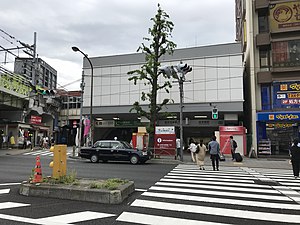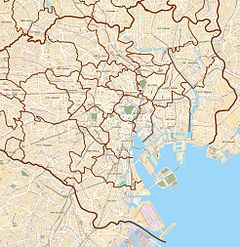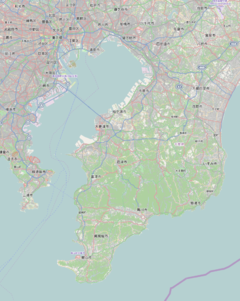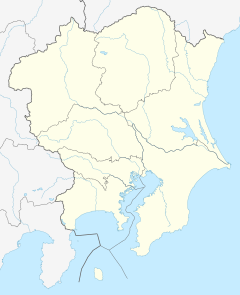This article needs additional citations for verification. (May 2021) |
Asakusabashi Station (浅草橋駅, Asakusabashi-eki) is a subway station on the Toei Asakusa Line operated by the Tokyo Metropolitan Bureau of Transportation, and a railway station above ground level on the Chūō-Sōbu Line at the same site operated by the East Japan Railway Company (JR East). It is located in the Asakusabashi neighborhood of Taitō, Tokyo, Japan. Its number on the Asakusa Line is A-16.
JB20 A16 Asakusabashi Station 浅草橋駅 | |||||||||||||||||||||
|---|---|---|---|---|---|---|---|---|---|---|---|---|---|---|---|---|---|---|---|---|---|
 The east side of the station in May 2019 | |||||||||||||||||||||
| Japanese name | |||||||||||||||||||||
| Shinjitai | 浅草橋駅 | ||||||||||||||||||||
| Kyūjitai | 淺草橋驛 | ||||||||||||||||||||
| Hiragana | あさくさばしえき | ||||||||||||||||||||
| General information | |||||||||||||||||||||
| Location | 1 Asakusabashi, Taitō City, Tokyo Japan | ||||||||||||||||||||
| Operated by | |||||||||||||||||||||
| Line(s) | |||||||||||||||||||||
| Platforms | 2 side platforms (JR East), 1 island platform (Asakusa Line) | ||||||||||||||||||||
| Tracks | 2 | ||||||||||||||||||||
| Construction | |||||||||||||||||||||
| Structure type | Elevated (JR East) Underground (Asakusa Line) | ||||||||||||||||||||
| Other information | |||||||||||||||||||||
| Station code |
| ||||||||||||||||||||
| History | |||||||||||||||||||||
| Opened | 1 July 1932 | ||||||||||||||||||||
| Services | |||||||||||||||||||||
| |||||||||||||||||||||
| |||||||||||||||||||||
Station layout
editJR platforms
edit| 1 | JB Chūō-Sōbu Line | for Akihabara, Shinjuku and Mitaka |
| 2 | JB Chūō-Sōbu Line | for Kinshichō, Funabashi and Chiba |
JR Asakusabashi Station has two side platforms with two tracks between them. Platform 1 is for passengers going toward Akihabara and Mitaka Stations. Platform 2 serves those bound for Kinshichō and Chiba Stations.
-
East ticket gates
-
JR platform, 2021
Toei platforms
edit| 1 | A Asakusa Line | for Nihombashi, Shimbashi, and Nishi-magome KK Keikyu Main Line for Shinagawa, Haneda Airport (International Terminal and Domestic Terminal), and Misakiguchi |
| 2 | A Asakusa Line | for Asakusa and Oshiage KS Keisei Line for Aoto, Keisei Narita, and Narita Airport (Terminal 2·3 and Terminal 1) KS Narita Sky Access Line for Narita Airport HS Hokusō Line for Imba Nihon-idai SR Shibayama Railway Line for Shibayama-Chiyoda |
Underground, the Asakusa Line station has an island platform between the two tracks. Trains on Platform 1 go toward Nihombashi and Nishi-magome Stations, while those on Platform 2 depart for the terminal of the subway line at Oshiage Station; through trains continue onward from there.
-
Toei ticket gates
-
Toei platform, June 2023
History
editAsakusabashi opened on July 1, 1932, as a station on the Sōbu Line. On December 4, 1960, the subway station on what was then known as Toei Line 1 began to operate.[citation needed]
On November 28, 1985, Asakusabashi Station was firebombed by masked members of the Revolutionary Communist League, National Committee,[1] who claimed that this action, as well as other acts of sabotage committed across several prefectures the same day were to support the 24-hour strike by the labour union Doro-Chiba protesting against the impending privatisation of Japanese National Railways (JNR).[2][3] This incident did not affect operations on the Toei Asakusa Line as the underground platforms were not targeted.[citation needed] 48 persons were arrested during an investigation.[4]
Surrounding area
editThe station serves the neighborhood. Nearby are the Lycée Franco-Japonais de Tokyo, the Kanda River, and the Sumida River. The former Yanagibashi geisha quarter was located to the south of the station.
See also
editReferences
editThis article incorporates material from 浅草橋駅 (Asakusabashi-eki) in the Japanese Wikipedia, retrieved on December 15, 2007.
- ^ "Train Service Returns to Normal in Japan". 30 November 1985.
- ^ "We live on railways--ch04".
- ^ Tifft, Susan (21 June 2005). "Japan: Paralysis on the Tracks". Time.
- ^ Haberman, Clyde (December 1985). "Japan's Polic Guard Against More Rail Sabotage". The New York Times.
35°41′49″N 139°47′10″E / 35.697°N 139.786°E




